Typeface Academy
How to create a webpage with Web Agent
Web Agent is an AI agent that streamlines end-to-end content workflows for webpages. Generate product pages, location-specific pages, blog posts, case studies, resource pages, and more with consistent messaging and design. This guide covers how you can use Web Agent to create and refine your webpages.
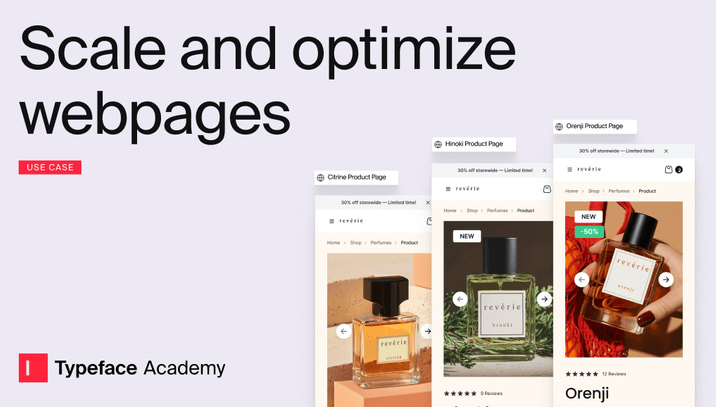
What you'll learn:
How to set up your account for success
Step-by-step webpage creation process
Editing and optimization techniques
How to scale content across audiences and languages
When to use Web Agent
Web Agent automates the creation of repetitive and structured webpages with standardized layouts. It's designed for high-volume web projects where you need to maintain consistent messaging and design across dozens or hundreds of pages.
Our customers typically use Web Agent to scale:
Product pages for a product catalog
Location pages across regions
Services pages across service offerings
SEO-optimized pages targeting long-tail keywords
Blog posts and articles
Case studies showcasing client success stories
Resource pages and knowledge bases
Installation and setup
Before you begin, it's important to set up your account so anyone in your organization can quickly generate on-brand, high-quality content.
Here are the key elements required for generating personalized webpages:
Brand Kit
Your Brand Kit ensures Web Agent generates content that aligns with your brand guidelines. Here’s how you can set up your Brand Kit:
Import brand guidelines, style guides, or messaging documents. Typeface automatically extracts brand data from your uploaded documents.
Review the extracted rules, edit, delete, or duplicate any rule, and add new ones as needed.
Finalize the brand kit.
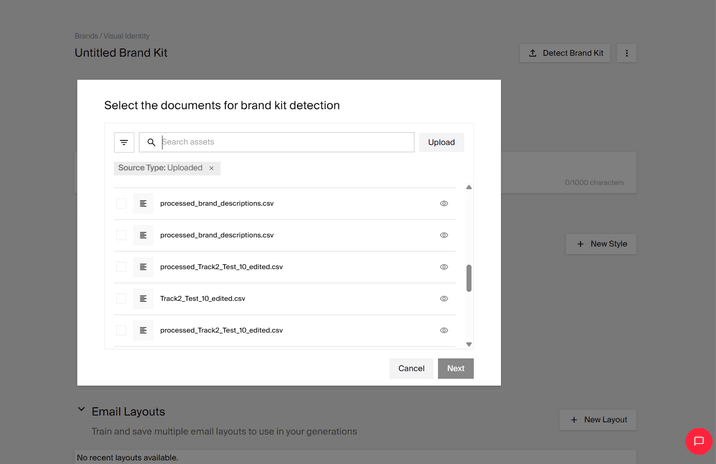
Layouts
Web Agent creates content in your approved, professionally designed HTML templates. You can import these files by
Uploading your file
Pasting the HTML code
Importing from Contentful
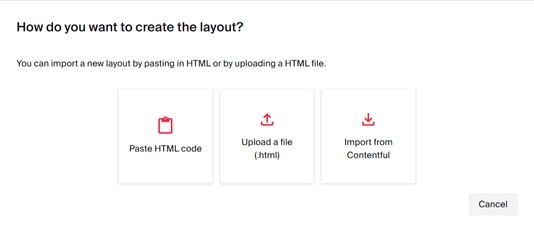
Audiences
Import or create Audience segments to refer to when creating web content. You can either manually create an audience segment or import audience segments from Customer Data Platforms or a file.
Once your account is set up, go through the next steps to create a webpage.
Creating webpages
1. In the chat box, type out your webpage goals and include optional SEO keywords you want to optimize for.
Use prompts like:
"Create a webpage for Typeface Email Agent. Optimize content for the keywords: Email, campaigns, AI, agent"
"Create a webpage highlighting AI Security in the Cloud Environment. Optimize content for the keywords: AI security, cloud environment"
"Create a webpage promoting our furniture offering in San Francisco. Tailor the content to San Francisco"
Need help getting started? Browse a few sample prompts for Web Agent.
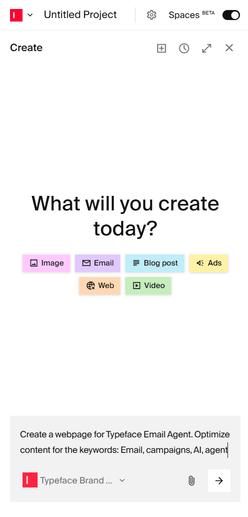
Tip
Tip
Include any on-page specifics and messaging in your prompt. You do not need to include brand details when your brand kit is already trained on your brand.
2. Click the paperclip icon in the chat box to add relevant attachments and supporting materials, like:
Assets: Add relevant documents (like product sheets or campaign briefs), URLs, images, or collections that contain information about your webpage topic
Layouts: Select from your pre-uploaded web templates
Audiences: Choose which target audience segments should influence the messaging and tone
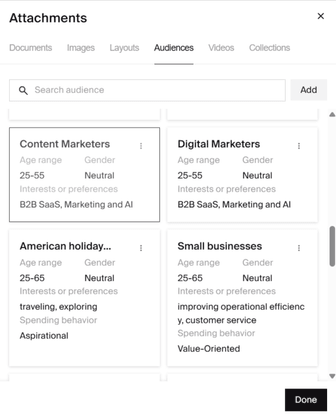
Note
Note
Web Agent may ask you to provide additional details before generating your webpage, such as selecting a specific layout or clarifying missing information.
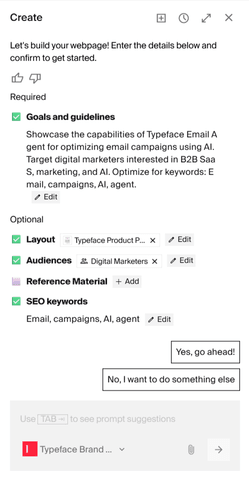
3. After you confirm all the details, the Web Agent will generate an on-brand webpage, complete with content sections, images, forms, buttons, and all other specified elements.
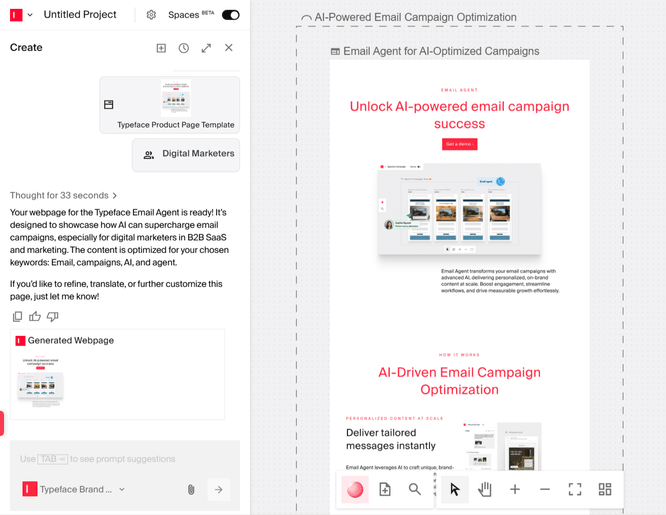
Editing webpages
Once Web Agent generates your webpage, you can refine individual elements, including the header, footer, copy sections, and any images. You can do this using the following editing options:
In-line copy edits
Highlight the text and click the red magic wand in the toolbar. This opens quick editing actions where you can refine the copy using AI.
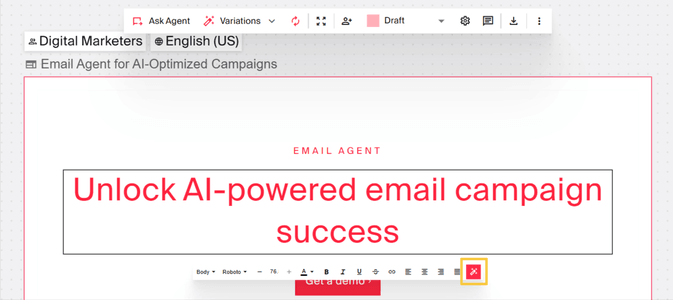
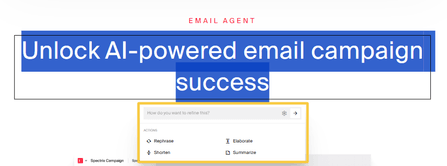
Image edits
Click directly on any image block to edit or replace it. You can also use AI to generate new images that match your brand style.
Create webpage variations
After you've finalized your webpage, you can scale it into variations by audience and/or language.
1. Click on "Variations" and choose between these three options based on how you want to create variations:
Audience: This allows you to create multiple versions of the same message customized for different audiences.
Language: Choose this option to generate versions of your content in different languages.
Mix & Match: This gives you the freedom to generate variations for various combinations of languages and audiences.
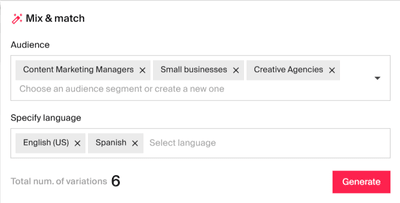
2. Web Agent will generate variations that maintain your core message while adapting the tone and language for each segment.
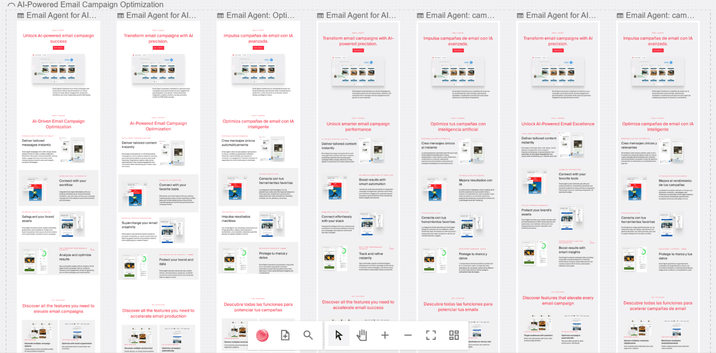
Exporting webpages
You can export your webpage as a CSV, HTML, PNG, JSON PDF, or Excel file. Web Agent also supports direct publishing to your CMS.
Try it out
Get started on scaling and optimizing webpages. To learn the topics covered in this guide, try out the following:
Create a webpage using your web layout
Create a webpage variation in another language
Preview and edit your webpage before exporting it
FAQs
What is a Web Agent?
Web Agent is an AI marketing agent that automatically generates on-brand webpages at scale. It can generate webpage content using your existing web layouts, eliminating manual, one-by-one page creation.
Does Web Agent take consider my word count limits?
Yes, layout content blocks can be annotated to include word count limits under the layout's "Additional Instructions."
How do I iterate on a webpage's content block?
Editing content blocks is simple. Just click on any content block within your generated webpage. From there, you can either manually type your edits or click the red magic wand icon to use AI-assisted editing.
How does Web Agent optimize webpages for SEO?
You can specify SEO keywords in your prompt. Web Agent structures content to maximize keyword relevance and consistency across pages.
What do I need to set up before using Web Agent?�
You’ll need your Brand Kit, approved web layouts, and audience segments to ensure every generated webpage is on-brand and tailored to your target users. Gather product sheets, campaign briefs, and any supporting assets for the best results.
How do I connect the Web Agent to my CMS or website?
Currently, you can export webpages in formats like HTML, CSV, PNG, JSON, PDF, Excel, and direct CMS publishing. For now, download your preferred format and upload it to your CMS manually.
Need more help? Contact support@typeface.ai.